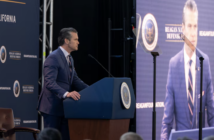Welcome to the CavasShips Podcast with Christopher P. Cavas and Chris Servello…a weekly podcast looking at naval and maritime events and issues of the day – in the US, across the seas and around the world. This week…US Navy leaders constantly talk about the need for fast-paced innovation – but what’s the real story? Is new technology being integrated into the fleet as fast as it can? We’ll hear from Leidos’ Dave Lewis, a former admiral deeply familiar with getting that technology into the hands of warfighters.
Please send us feedback by DM’ing @CavasShips or @CSSProvision or you can email chriscavas@gmail.com or cservello@defaeroreport.com.
This Week’s Naval Round Up:
The US destroyer MILIUS carried out a freedom of navigation operation March 24 near the Paracel Islands in the South China Sea. It was the first such FONOPS by a US Navy warship since November. The US Navy’s statement on the movement was unusually lengthy and repeated many of the concerns by the United States about China’s, quote, “unlawful and sweeping maritime claims in the South China Sea.” The statement also pointed to other nations, including Taiwan and Vietnam, who make what the US consider to be excessive maritime claims. Chinese reaction was swift, with a Defense Ministry spokesman issuing a statement condemning the US for illegally entering what it claims are Chinese territorial waters.
The aircraft carrier USS THEODORE ROOSEVELT left Puget Sound Naval Shipyard March 17 after a 20-month drydocking overhaul. The Big Stick returned to her homeport of North Island, San Diego on March 24. Meanwhile, in Japan the amphibious dock landing ship USS ASHLAND left Sasebo March 22 to return to the US after nearly a decade operating with the US Navy’s Forward-Deployed Naval Forces Japan. ASHLAND is scheduled to be decommissioned some time after returning to San Diego.
Three patrol coastal vessels – USS HURRICANE PC 3, USS SIROCCO PC 6 and USS THUNDERBOLT PC 12 – were decommissioned March 20 in a ceremony at Alexandria, Egypt, where on the following day all three were transferred to the Egyptian Navy. The PCs had been based with the US Fifth Fleet at Manama, Bahrain and sailed to Egypt with combined Egyptian-US Navy crews. A total of ten US Navy PCs at one time were based at Bahrain, and the last two, USS MONSOON PC 4 and USS CHINOOK PC 9, will be decommissioned March 24 and soon be transferred to the Philippines. The PCs have not been replaced in service with the Fifth Fleet.
And the research vessel PETREL suffered a calamity March 22 when high winds dislodged the ship while in a drydock at Leith, Scotland, sending it off its blocks to lie to one side at about a 45-degree angle. The ship was purchased by the US Navy in September, and is well known as the floating base of the shipwreck-finding expeditions funded by the late Microsoft co-founder Paul Allen. The team aboard PETREL established a reputation as the world’s greatest shipwreck finders – among their finds were the sunken US aircraft carriers LEXINGTON, WASP and HORNET, the cruiser INDIANAPOLIS, the Japanese battleship MUSASHI and many others. The team was disbanded, however, after Allen’s death and the subsequent worldwide pandemic, and the Navy bought the ship and all its gear for an undisclosed mission. It is not yet clear if the PETREL will be repaired or not.
Cavas Squawk:
As noted above, the US Navy just decommissioned three more Patrol Coastal vessels – commonly referred to as PCs – and transferred them to a friendly nation. Within days, the last two will also leave service and, like most of their sisterships, will soon be in service under the flag of a partner nation. And thus will come to a close the unlikely history of the Patrol Coastals in US Navy service.
It was one heck of a convoluted story. Briefly, during the late 1980s the US Navy’s special warfare community wanted a larger vessel for covert insertion and extraction operations, and the Navy adapted a British patrol boat design to the mission. But when the first ship, CYCLONE PC 1, entered service in 1993, the special warfare operators complained it was too large, and the community quickly disavowed them. Too late to stop the procurement of 12 more sisterships, all of which were delivered by 1995 to a Navy that really didn’t want them. After all, these were small, brown water ships not designed for the open-ocean blue water fight the US Navy’s culture loves so well. Various ideas were floated for what to do with them – some commanders thought they’d be quite useful to interact with smaller navies whose entire fleets were smaller than one single US destroyer.
Some folks thought they should go to the Coast Guard, and the CYCLONE herself was decommissioned and placed in Coastie service in 2000, but it was quickly apparent the ships were unsuitable for Coast Guard missions. Efforts were then in hand to decommission the entire class.
Then along came 9/11, and all of a sudden there was an urgent requirement for ships to patrol the harbors of the United States. Voila, a mission the PCs could perform and free up larger and more valuable warships for fleet missions. Some were even placed under Coast Guard command. But it was a relatively short-lived role, and some of the ships were effectively taken out of service. Maintenance funding was cut, some of the patrol coastals became spare-parts assets for others.
And then came Operation Iraqi Freedom, and a greatly enlarged US presence in the MidEast and the Persian Gulf in particular. Beginning in 2004, PCs were sent to operate with the US Central Command’s Fifth Fleet based in Manama, Bahrain. Eventually 10 of the PCs were based there. All were modernized, refurbished and upgunned for the new mission. And here they finally found a home. The PCs were famously busy ranging throughout the Gulf and out into the Gulf of Oman and the Arabian Sea, frequently used as escorts for larger warships up to aircraft carriers moving in and out of the Strait of Hormuz.
So now, after more than a quarter century of the US Navy trying to get rid of them, the PCs are ending their American service lives. The lesson here is one of adaptability. The ships never performed their intended mission, but rather were adapted into roles unforeseen when they were built. They may not have been the absolutely best asset for these new missions, but they were good enough, and in the end gave a great return to the taxpayer for a relatively minimal investment.
This isn’t the only time a ship or aircraft or weapon turned out to be quite effective in something other than what it was designed for. Actually, history is replete with such examples. I think of this often when I hear senior military officials complain that some relatively-new asset isn’t exactly what they want, that they want to get rid of it and instead plow more resources into buying another shiny bright object that won’t be here for years to come.
Rather than throwing things away early that have much life left in them, I’d rather be hearing about how assets that exist right now can be adapted to effectively carry out new missions.
Oh but I know, that’s not nearly as much fun as getting that shiny new thing.




